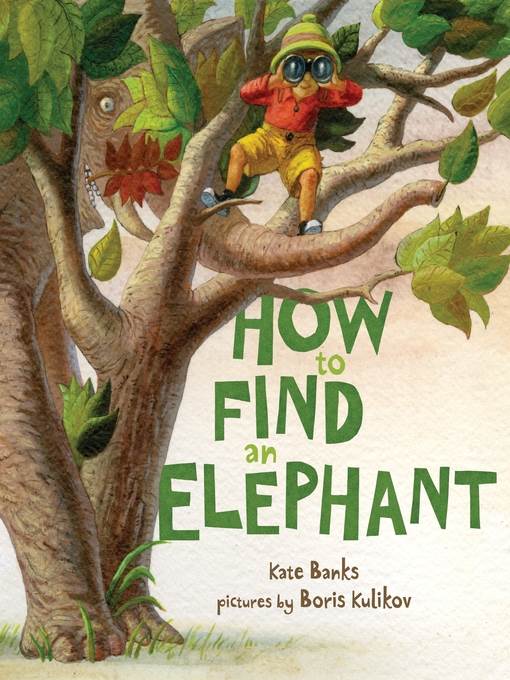
How to Find an Elephant
فرمت کتاب
ebook
تاریخ انتشار
2017
Reading Level
0-2
ATOS
3.3
Interest Level
K-3(LG)
نویسنده
Boris Kulikovشابک
9781466897533
کتاب های مرتبط
- اطلاعات
- نقد و بررسی
- دیدگاه کاربران
نقد و بررسی

Starred review from September 18, 2017
It’s a gray and slightly rainy day—what better time to go looking for an elephant? The pith-helmeted backyard explorer
created by longtime collaborators Banks and Kulikov (the Max series) doesn’t encounter his quarry until the final pages, but the elephant is not nearly as elusive as the boy thinks it is: readers can spot the grinning creature throughout, whimsically camouflaged into lush paintings that blend fantasy and reality. As the second-person guidebook-style language offers pro tips (“The first thing you will want to do is climb to the top of the nearest tree”) and salient points (“Don’t forget elephants are fine swimmers”), there are false alarms (a rhino looks a lot like an elephant), wild adventures (a monkey takes the boy for a swing), and many lovely, graceful moments. In one spread, readers see the world through a pair of rain-dotted binoculars; in another, the boy and several animals walk on tiptoe while the elephant, hidden by trees, does the same. Forget about the elephant in the room—the one in your imagination is a lot more fun. Ages 3–6. Author’s agent: Rick Margolis, Rising Bear Literary.

August 1, 2017
This tongue-in-cheek text gives instructions on elephant-discovery methods when boredom threatens; the art shows an earnest, but oblivious, child on safari--and camouflaged elephants galore. The young child is light-skinned, blue-eyed, and fair-haired, with gender unknown. Following the (rather pedantic) narrator's instructions, the child moves from idleness to an elephant quest. The child's prescribed gear--including binoculars, a flute, and a blanket "that's tasseled and brightly colored, with a story woven through the cloth"--awaits a backpack near a beckoning doorway. Page after page, the text gives pointers on elephant-spotting, while the sophisticated, textural artwork allows young readers to spot elephants that the obedient, fictional child does not see. A mostly pastel palette backgrounds the brightly clad child, veering freely between an imaginary jungle and tamer spaces. A particularly funny double-page spread shows the child filling up a bright red water bottle and standing on what appears to be a rock in a watering hole. The water is actually spurting from the trunk of a mostly submerged elephant, and the child is unwittingly perched on its large, rough knee. Although, in the end, child and elephant are merrily, consciously linked, the final whimsical image contradicts advice given much earlier--"look for something large and gray"--and compels readers to revisit the entire book. Another tribute to imagination from highly creative partners. (Picture book. 3-7)
COPYRIGHT(2017) Kirkus Reviews, ALL RIGHTS RESERVED.

November 1, 2017
PreS-Gr 2-An imaginative, elephant-loving young explorer goes on an adventure to find one in the wild. Outlining all the necessary supplies an elephant explorer should have, he ventures out, providing a step-by-step guide to addressing the expected and the unexpected as they occur. This title's approach to the unknowns of exploration is full of humor and pragmatism. Although not the most exciting or adventurous read, it has a good deal of heart and excels at giving young readers interesting facts about elephants such as, "don't expect to hear the elephant's footsteps, because they walk on tiptoe" or "elephants are fine swimmers." Readers also learn that the pachyderms have large appetites, so having plenty of bamboo shoots and tree bark handy is helpful. However, the book's greatest achievement is its illustration, which perfectly meshes with the text. The lush shades of green, blue, and brown in the landscape allow for subtle optical illusions in the wild that young readers will enjoy identifying. VERDICT For extra-curious, nature-loving, budding explorers, this engaging title is a real treat.-Maegen Rose, Collegiate School, New York City
Copyright 2017 School Library Journal, LLC Used with permission.

October 15, 2017
Preschool-G Nothing to do on a gray, cloudy day? Why not go in search of an elephant? The child in this look-and-look-again expedition packs up the necessary equipmenta blanket, water bottle, binoculars, and a fluteand heads out in search of the elusive mammal. Dressed in khaki shorts and a pith helmet, the searcher has a plan: look for elephant tracks and climb a tree to see if one is in the area. Unobserved by our intrepid explorer, signs of an elephant are hidden in plain sight: a leg that resembles a tree, a trunk that matches a branch exactly, a pair of eyes peering through stalks of bamboo, and even in the absence of any color. A chimpanzee, an eagle, a rhino, and a cricket in a bowtie add to the adventurer's delight (and are examples of a child's vivid imagination). Kulikov's colorful and playful mixed-media illustrations are a joy to peruse. With an elephant skillfully camouflaged on every page, adults and children will take delight in finding and pointing it out.(Reprinted with permission of Booklist, copyright 2017, American Library Association.)

























دیدگاه کاربران